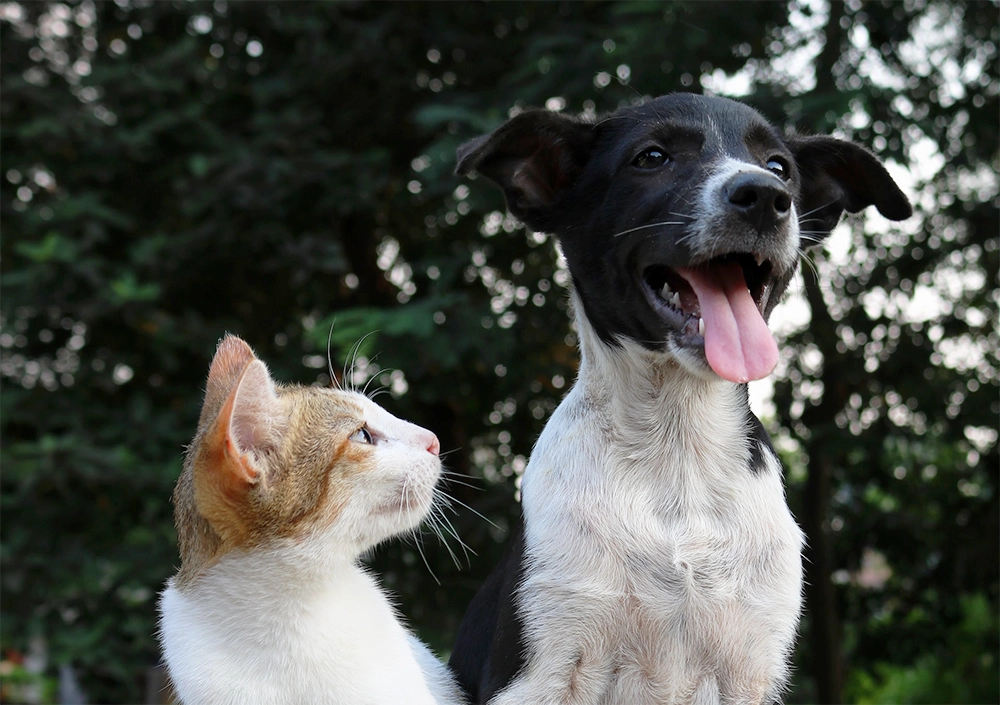The old phrase, “fighting like cats and dogs,” is a part of our lexicon because it mostly rings true. Put any cat and dog in a room together for the first time and there’s a pretty good chance that they won’t get along, if for any other reason than the dog might be too interested in the cat, who would rather be left alone.
But while the phrase is a common one, it doesn’t always have to be the case in the real world. Usually, dogs and cats don’t get along because they haven’t been properly introduced to each other. By taking the appropriate steps, it is entirely possible for your dog to accept your new cat (or vice versa). In fact, you might even be surprised to see that over time they become best friends.
If you want to learn how to introduce a cat to a dog, then there are a few different techniques you can use. The following will explain each step, so you can use the one that makes the most sense to you.
Gradual Desensitization Technique
When you bring your new cat home, don’t let her have the run of the house right off the bat. This will result in your dog becoming too fixated on her to the point that she may react negatively. Instead, keep your cat in a separate room with a closed door. Have everything in the room that she might need, from her litter box and toys to a bed and a place to eat and drink.
Your dog’s sensitive nose will inform her that something is in that room, so she will probably sniff along the bottom of the door regularly. After some time has passed, the next step in the introduction is to use a baby gate to block the doorway. With the gate solidly in place and your dog on a leash, open the door. Hold the leash, so your dog doesn’t get too excited and blast through the gate. The goal here is for the cat and dog to see and smell each other. After a minute or two, close the door and give your dog a treat for being good.
Continue these short visits for as long as it takes for your pets to show a sense of familiarity and comfort with each other. You can also feed your pets on either side of the door and swap their bedding from time to time. This will also help each pet to become familiar with the other’s smell.
Face-to-Face Introduction
A face-to-face introduction isn’t for everybody, but if your dog has a relaxed disposition and your new cat is either very young or also has a relaxed nature, then this technique will help the two get to know each other much quicker. This type of introduction requires two people, one to hold the dog’s leash and one to watch the cat. Regardless of how relaxed you might think your pets are, anything can happen, so it pays to be as safe as possible.
The key to this technique is to stay focused on each pet’s body language. Command your dog to sit and stay and then let your new cat roam freely. Praise and reward your dog for ignoring the cat while she walks around and sniffs your dog. However, if your dog becomes fixated on your cat or lunges at her, then a more gradual introduction technique should be used.
“Look At That” Introduction Technique
Every dog has her own threshold when on the leash. Her threshold is the point where she becomes so fixated on something that she stops listening to you when you call her name. When using the “Look at that” technique, the first thing you need to do is to determine your dog’s threshold. Keeping your dog on her leash, let her get as close as possible to the cat as long as she looks at you when you call her name. If your dog lunges or stops listening to you, then she’s reached her threshold.
The next time you introduce your cat to your dog, keep your dog on the leash and use a clicker and have treats ready. Let her get closer to the cat and then use the clicker to take her attention off of the cat. If your dog stops fixating, then reward her with a treat and praise. Continue this process until she can get close to the cat while still being able to listen to your commands. This process can take time, so patience is a must. Remember, the more nervous or impatient you are, the more aggressive your dog will be.
Introducing Puppies and Kittens
Puppies and kittens are naturally curious and they don’t harbor the same feelings as older pets. When introducing a kitten to your dog or a puppy to an older cat, the most important thing to do is to pay attention to how the older pet is acting. If the older pet starts acting agitated or becomes too fixated, remove the younger pet from the situation. In this situation, using the desensitization technique would be recommended.

